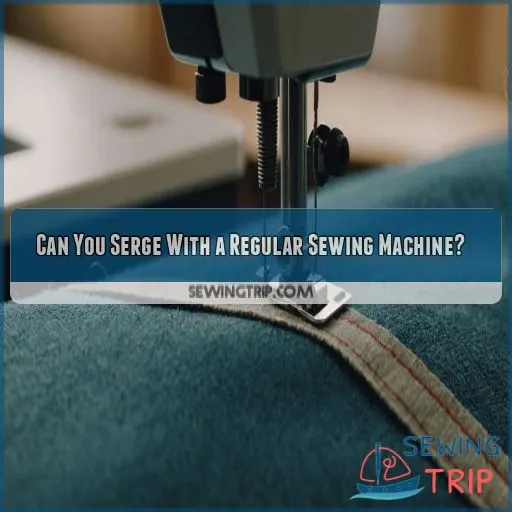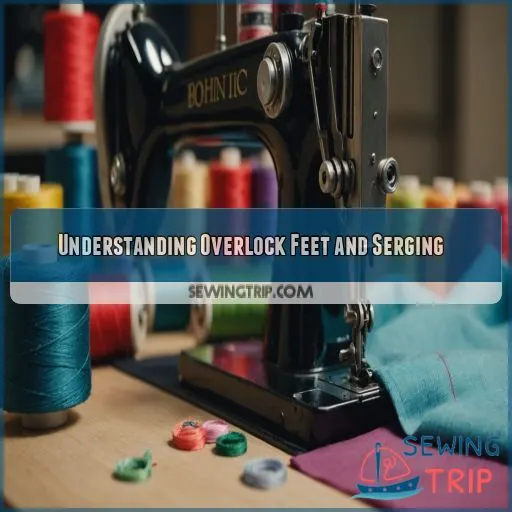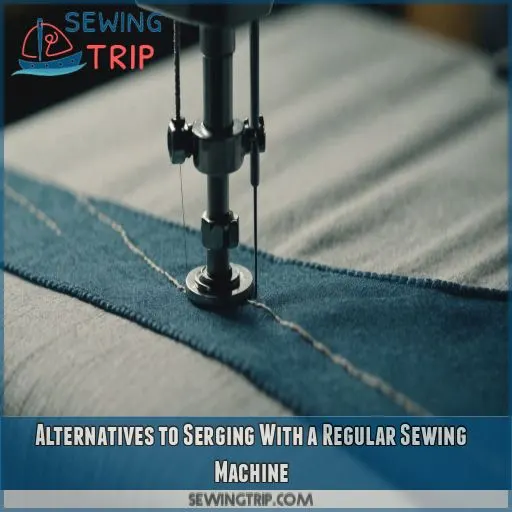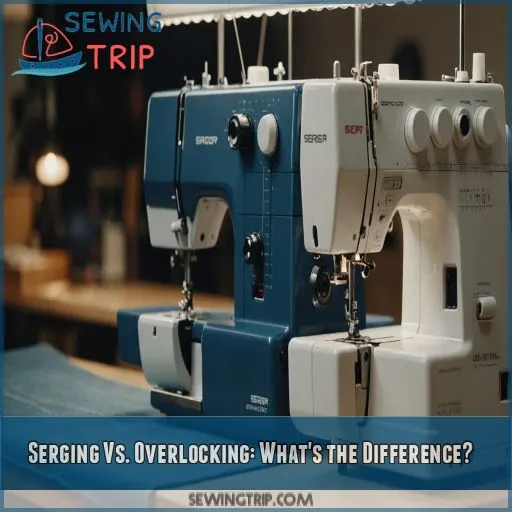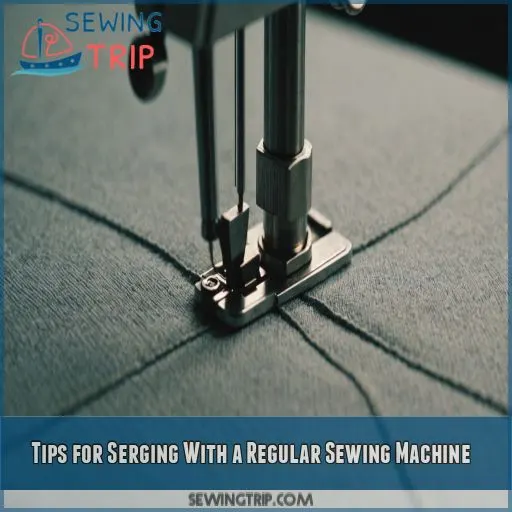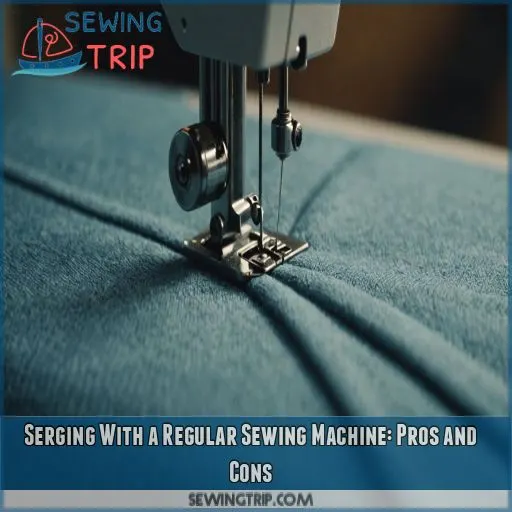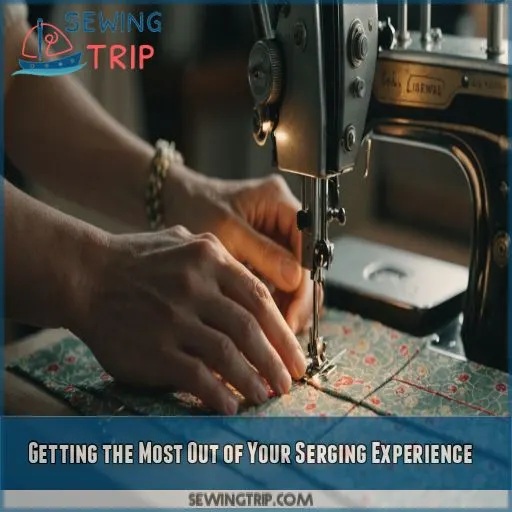This site is supported by our readers. We may earn a commission, at no cost to you, if you purchase through links.
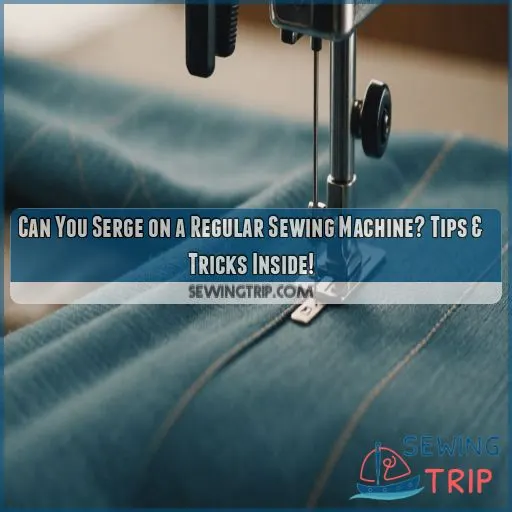
Grab some overlock feet, and you’ll mimic serger magic without splurging on a new gadget.
It’s like finding a new tool in Grandma’s attic—unexpected yet handy.
Overlock feet let your machine finish edges with neatness akin to a serger’s, just not with all the trimmings.
Sure, a serger trims and locks in one go, but with the right tweaks, your trusty sewing machine becomes a force to reckon with.
Achieving high-end results might feel like balancing a tightrope, but once mastered, you’ll be sewing up a storm in style.
Curious how? Stick around!
Table Of Contents
- Key Takeaways
- Can You Serge With a Regular Sewing Machine?
- Understanding Overlock Feet and Serging
- Alternatives to Serging With a Regular Sewing Machine
- Serging Vs. Overlocking: What’s the Difference?
- Tips for Serging With a Regular Sewing Machine
- Serging With a Regular Sewing Machine: Pros and Cons
- Getting the Most Out of Your Serging Experience
- Frequently Asked Questions (FAQs)
- Conclusion
Key Takeaways
- You can definitely serge with a regular sewing machine using an overlock foot, turning your trusty machine into a budget-friendly substitute for a serger. It’s like transforming a pumpkin into a carriage – practical magic for your sewing projects!
- While sergers trim and finish in one swoop, your sewing machine can mimic the serger’s neat edge finish minus the blade. It’s a bit like trying to juggle with one hand, but with practice, you can master it.
- Serging with your sewing machine is a great way to improve edge stability and prevent frays without breaking the bank. It’s like finding a hidden gem in a thrift store – unexpected yet perfect for your needs.
- Although serging on a sewing machine takes more time and offers fewer stitch options, with the right tweaks and techniques, such as ladder stitches, you can still achieve professional-looking results. Think of it as cooking a gourmet meal with a toaster oven!
Can You Serge With a Regular Sewing Machine?
Can you serge on a regular sewing machine? The good news is, you absolutely can! While a dedicated serger offers a professional-looking finish, your trusty sewing machine can get the job done with the right techniques and accessories.
What is Serging and How Does It Work?
Imagine achieving seamless results! Serging is all about looping threads to finish raw edges using a serger blade. Here’s how it works:
- Trim edges: Think of it like a haircut for fabric.
- Loop threads: Encase seams for durability.
- Finish professionally: Forget frayed edges!
Differences Between Serging and Sewing
Serging and sewing differ mainly in finishing. Sergers trim seams and encase raw edges, offering superior edge finish quality and seam strength. Sewing machines, paired with an overlock foot, create faux-serged finishes. These overedge stitches enhance fabric handling and stitch versatility.
Benefits of Serging With a Regular Sewing Machine
Serging with a regular sewing machine might seem like finding a needle in a haystack, but it offers real perks:
- Improved edge stability: Keep fabric from fraying.
- Cost-effective: No need for a serger purchase.
- Versatile stitch options: Experiment and enjoy!
Understanding Overlock Feet and Serging
Ever wondered how a regular sewing machine can mimic a serger? Meet the unsung hero: the overlock foot! It’s like turning a pumpkin into a carriage—a game-changer for edge finishing techniques. Overlock feet come in various types, each with its quirks:
| Overlock Foot Type | Stitch Compatibility | Suitable Fabrics | Possible Adjustments |
|---|---|---|---|
| Basic Overlock | Zigzag | Cotton, linen | Stitch width |
| Edge Joining | Blind hem | Lightweight | Stitch length |
| Elastic Overlock | Stretch stitch | Knit fabrics | Edge tension |
| Piping Foot | Straight stitch | Medium weight | Pressure foot |
Each has potential to bring out the best in your sewing machine, transforming it into a close comrade of a brother 1034d.
Alternatives to Serging With a Regular Sewing Machine
If you’re looking to finish your garment’s edges without a serger, don’t worry—your regular sewing machine has plenty of tricks up its sleeve! From ladder stitches that magically disappear to secure pin stitches, you’ve got a toolkit of creative alternatives that’ll have your seams looking neat and professional.
Using Ladder Stitches as a Serging Alternative
You’ve explored overlock feet; now consider ladder stitches. They’re the acrobats of sewing! With impressive versatility and stability, ladder stitches can hem pants or secure fabric edges like pros. It’s like getting a serged finish without the big top drama.
Using Pin Stitches for a Serging Effect
Utilize the pin stitch technique for securing fabric edges, especially with delicate fabric finishing. Enhance your seams with decorative edges, enjoying the stitch versatility it offers:
- Easy setup
- Sturdy hold
- Delicate handling
- Creative design
- Time-efficient styling
Other Serging Alternatives for Regular Sewing Machines
Don’t fret if you’re missing a serger! Explore an array of decorative stitch options like zigzag, scallop, or blanket stitch. These hemming techniques and edge finishing tips, alongside clever faux serge methods, transform sewing accessories into your secret weapons.
Serging Vs. Overlocking: What’s the Difference?
Ever wondered why overlocking sounds like an extreme sport while serging seems like a term your grandma would use for sewing? Both techniques offer a professional finish but understanding their quirks can help you decide whether to embrace that snazzy overlock stitch or stick with trusty serging when creating your next masterpiece.
Definition of Serging and Overlocking
Let’s explore serging origins and overlocking evolution. Serging, like taming a wild thread beast, trims and binds edges in one go. Meanwhile, overlocking simplifies edge finishing. Understanding these stitching techniques emphasizes the importance of thread tension in achieving professional results.
Key Differences Between Serging and Overlocking
Serging, like a sewing machine on turbo, trims and encases fabric edges for a polished look. Overlocking shares this ability but varies in stitch formation, thread usage, and edge finish. While sergers race ahead, sewing machine capability still impresses.
When to Use Serging Vs. Overlocking
Now that you understand the key differences, think of serging as the robust, professional look for heavier fabrics and high-wear garments. Overlocking is more versatile and user-friendly; it’s perfect for lightweight fabrics requiring ease and elegant finishes.
Tips for Serging With a Regular Sewing Machine
Serging on a regular sewing machine takes some practice, but it’s totally doable! Get ready to prep your fabric, choose the right thread, and troubleshoot any pesky issues – we’ve got your back with these handy tips.
Preparing Your Fabric for Serging
When you’re ready to surge full-speed ahead with serging, first stabilize your fabric. Trim those edges neatly, check your seam allowances, and make sure your thread tension matches your fabric choice. It’s like setting the stage for a sewing performance!
Choosing the Right Thread for Serging
When serging on a regular sewing machine, choose a lightweight, high-quality thread that matches your fabric. Experiment with different thread weights and colors to achieve the perfect serged finish. Proper thread tension is key for clean, professional results.
Troubleshooting Common Serging Issues
Experiencing tension issues? Adjust your presser foot and replace that needle. Unsure about threading? Follow the sequence carefully. Looper acting up? Troubleshoot with patience – you’ve got this! Serging takes practice, but you’ll be a pro in no time.
Serging With a Regular Sewing Machine: Pros and Cons
Thinking about serging with your regular sewing machine? Let’s weigh the pros and cons—it’s like deciding between coffee and tea, both have their perks and pitfalls!
Advantages of Serging With a Regular Sewing Machine
Serging with a regular sewing machine reveals a world of benefits! Youll save a pretty penny compared to investing in a pricey serger. Space efficiency? Check! Adaptability reigns supreme as your trusty machine tackles multiple tasks. And let’s not forget the learning opportunitiesits a hands-on way to master sewing! Who knew serging could be this accessible?
Disadvantages of Serging With a Regular Sewing Machine
Now, let’s talk about some drawbacks of using a regular sewing machine for serging. You might notice limited stitch variety, which feels like choosing shoes from a closet with only two pairs. It’s a slower sewing process, often resembling a snail’s pace, leading to less professional finishes with increased seam bulk and frequent thread adjustments.
Getting the Most Out of Your Serging Experience
Ready to serge like a pro with just your regular sewing machine? Let’s explore some tips to refine your techniques, experiment with stitches, and keep your machine humming smoothly, so you can turn your projects into masterpieces!
Practicing Serging Techniques for Better Results
Start practicing serging with some projects! Experiment with different fabric types and adjust thread tension and stitch length. It’ll take some trial and error, but mastering these techniques is like riding a bikeyou’ll find your balance with perseverance.
Experimenting With Different Serging Stitches
Explore your creativity by experimenting with different serging stitches! Try:
- Decorative overlock stitches for a unique edge finish.
- Combining thread colors for a fun, personalized look.
- Adjusting stitch length and tension for a professional result.
- Exploring stitches on various fabric types to find your favorites.
Maintaining Your Sewing Machine for Optimal Serging Performance
Keeping your sewing machine in tip-top shape is like giving your car a tune-up. Regular cleaning, lubrication, picking the right needles, and mastering thread tension can prevent your projects from going haywire when chasing that perfect faux-serged finish!
Frequently Asked Questions (FAQs)
Can you use a regular sewing machine to Serge?
Like a well-oiled machine, your trusty sewing machine can mimic the serger’s magic with the right overlock foot. Boost your creativity and achieve a professional-looking finish, no serger required – just a dash of sewing savvy and a pinch of practice.
Can you overlock on a normal sewing machine?
You can overlock on a regular sewing machine using an overlock foot for that serger-like finish. It’s like giving your seams a little massage—keeps them neat, tidy, and fray-free without the fancy equipment!
Do all sewing machines have a serger?
Exploring the sewing world, you’ll find that not all machines come with a serger. Think of it as missing the fairy godmother in sewing’s ball; you can improvise with a regular machine using overlock feet to achieve similar results.
Can I use serger thread in my sewing machine?
You can use serger thread in a sewing machine, but it requires tweaks. Adjust tension for smoother stitching and consider a spool holder to prevent tangles. Although not as strong, it’s a budget-friendly alternative (Source).
What fabrics are best suited for serging?
Think of serging as a tailor’s magic wand: perfect for stretchy fabrics like knits, ensuring they don’t unravel. Use it on heavier fabrics like denim for durability. It’s your secret weapon to master neat and durable seams!
How does serging impact fabric durability?
Serging strengthens your seams by preventing future frays and tears, much like adding a superhero cape to your fabric. This creates a durable, professional finish while extending the garment’s life—it’s like giving fabric a spa day.
Is thread quality crucial for serging?
Thread quality for serging is like the backbone of a strong bridge. You don’t want frayed support! Using high-quality thread prevents breakage, makes sure stitches are smooth, and ultimately guarantees your seams withstand the test of time.
Can decorative threads be used in serging?
Absolutely, you can use decorative threads for serging to add flair and creativity to your projects. From metallic to textured threads, they transform ordinary seams into spectacular finishes, making your creations look professional and unique (Source).
Are special needles required for serging?
For serging, special overlock needles are typically recommended for best performance. Brands like Schmetz offer specific serger needles marked ELx705 or 130/705 H, designed to handle the high speed and demands of a serger (Source).
Conclusion
Picture your sewing machine as the trusty steed of a Knight Templar, and you’ll realize it’s more versatile than it seems!
Yes, you can serge on a regular sewing machine with the right tweaks.
Overlock feet and alternative stitches open up a world of neat, professional finishes without the need for extra gadgets.
Just remember, practice makes perfect, and your sewing projects will look serger-worthy in no time.
Embrace the challenge and sew your way to success!

